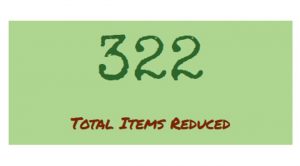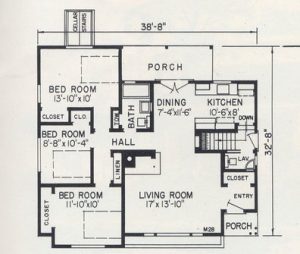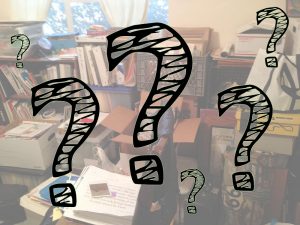 It seems like it should be simple – to get rid of the clutter in our lives – but it’s not. Dealing with clutter can be an overwhelming endeavor and many people put it off because they don’t know where to start or they can’t bring themselves to take the first step. There’s just so much stuff to process or all the stuff produces a sort of anxiety. That anxiety likely comes from the fact that you didn’t accumulate clutter. Every individual thing that came into your home came into it for a reason and you have kept it for a reason. In order to get rid of it, you have to address that reason and decide if it is still valid for you, or for other members of your household.
It seems like it should be simple – to get rid of the clutter in our lives – but it’s not. Dealing with clutter can be an overwhelming endeavor and many people put it off because they don’t know where to start or they can’t bring themselves to take the first step. There’s just so much stuff to process or all the stuff produces a sort of anxiety. That anxiety likely comes from the fact that you didn’t accumulate clutter. Every individual thing that came into your home came into it for a reason and you have kept it for a reason. In order to get rid of it, you have to address that reason and decide if it is still valid for you, or for other members of your household.
It took us awhile, and several failed attempts over the years, to decide on a de-cluttering strategy that works for us (at least it’s working so far!). To figure out what works for you, start by figuring out your goal for the project and then put together an approach that fits that goal and the other elements of your life and personality.
You Need a Mission to Stay Motivated
The very first thing you need to do, well, after you deal with the low-hanging fruit, is to figure out exactly why you want to de-clutter. You may think that this is obvious, but it might not be. There are many different reasons that people decide to remove the clutter from their lives. If you’re like us, you’ll probably have several reasons that combine to motivate you to (finally!) deal with the stuff in your life.
Here are some of the common reasons to de-clutter:
- You are downsizing to a smaller home
- You need to sell off stuff to raise money for bills or a specific expense
- You are tired of not being able to find things when you need them
- You feel that your home is a health hazard/fire hazard
- You want to create a more serene or peaceful environment
- You want to give your unused stuff to someone who will use/enjoy them
 In our case, there’s a philosophical reason for our Radically Reducing project: we feel that our stuff weighs us down and anchors us to a specific way of life. In order to have the life we want, we have to first free ourselves from the stuff. On the practical side, there’s only so much room in an RV and we don’t want to feel crowded by stuff once we get on the road. Historically, nomads didn’t have a lot of stuff.
In our case, there’s a philosophical reason for our Radically Reducing project: we feel that our stuff weighs us down and anchors us to a specific way of life. In order to have the life we want, we have to first free ourselves from the stuff. On the practical side, there’s only so much room in an RV and we don’t want to feel crowded by stuff once we get on the road. Historically, nomads didn’t have a lot of stuff.
Spend some time today figuring out what YOUR reason for de-cluttering is. What is driving your desire to clear your home? How will your life be different once the clutter is gone? Try creating a simple mission statement for your project. Write it down and consider putting it in a prominent place in your home so your whole family can see it throughout the project. When the sorting gets tough, and it will get tough, remembering your mission may provide the spark you need to keep going.
Maybe you don’t need a mission statement because you are so motivated and so ready to get this done you just want to know how to dig in to the work.
Choosing the Best Approach for You
How do you know which way to clear your home? If you google “get rid of clutter” there’s over half a million articles and websites. Amazon.com has nearly 1000 “de-cluttering books.” – and that’s just for those specific search terms.
There are five general approaches to clutter:
- Number-based
- Time-based
- Space-based
- Category-based
- Value-based
These approaches are rarely isolated, but rather people combine them into an approach that works for them. It’s a matter of choosing the primary approach that is going to push you forward in your de-cluttering so that one thing leads to another and another.
Do You Want to Count Down or Add Up?
 If you like counting things and having specific goals, choosing a number system may be for you. You can choose to count what you keep or what you eliminate from your life. For example, there are some minimalists who seek to have only 100 items in their life and steadily reduce until reaching that goal. On the other hand, you could take the “1000 Things Challenge” and attempt to get rid of at least 1000 individual items.
If you like counting things and having specific goals, choosing a number system may be for you. You can choose to count what you keep or what you eliminate from your life. For example, there are some minimalists who seek to have only 100 items in their life and steadily reduce until reaching that goal. On the other hand, you could take the “1000 Things Challenge” and attempt to get rid of at least 1000 individual items.
If you’re looking for a combination of the two you can decide that you want to eliminate a certain percentage of stuff from your life. Then you can translate that to a number that you use as a guideline. Say you want to reduce the stuff in your house by 30%. That means that as you sort through your books, you keep seven out of every ten. If you have twenty pairs of shoes, donate six.
One important note here: if you’re going to count things, you need to set a system for your counting. Does each individual sock count or are you counting them as a pair? Does a season of a TV show on DVD count as one season or as five individual DVDs? If you are counting what you keep, are you excluding shared use items, like the kitchen table or sofa or does everything you use count as your 100 things? Figure out your system in advance and make sure everyone in your family knows it. You can find the counting rules for our project here.
How Much Time Do You Have?
If time is at a premium in your life you may need to de-clutter according to a schedule. There are systems out there that show you how to de-clutter in specific increments, from as little as 30 seconds up to a month-long or even eight-week program. Many will suggest you set a timer for 10 minutes or 15 minutes or 30 minutes and attack the clutter for short bursts. This allows you to feel a sense of accomplishment without getting overwhelmed by the size of the project. You’re not de-cluttering your whole house, you’re just spending a few minutes on a smaller task. If you’re someone who wants the satisfaction of getting it all done at once, you may want to set aside a weekend or a big block of time every night for a week and approach the problem that way.
Room-by-Room or Category-by-Category?
 Most people will pick one of these two approaches, even when combining it with another. For example, we are counting what we eliminate and sorting by category. Those who are counting can use either approach. Those who are time-based usually go for the room approach.
Most people will pick one of these two approaches, even when combining it with another. For example, we are counting what we eliminate and sorting by category. Those who are counting can use either approach. Those who are time-based usually go for the room approach.
In the room-based approach you tackle one room of your house at a time and thoroughly sort everything in that room into keep, sell, donate, or trash. Some people also add a relocate category if something needs to be moved to a different room of the house. The main appeal of this approach is that you can see immediate results by doing just one room. That satisfaction can serve as motivation to move to the next room – and the next and the next. Most people choose to start with the more public rooms of the house or the ones that you spend the most time in, leaving the basement, attic, and garage for last.
Using the category approach takes a bit more effort, but works for those who prefer the “big picture” of their stuff. You gather all of one category, say books, from all over you home. You put them in one big pile and sort it in one go. This helps you understand just how much stuff you have spread around your home and may even reveal duplicates or forgotten stashes of things. An additional benefit is that you can then make decisions about where things will live after the purge and set up systems to prevent losing track in the future.
What Do You Value in Your Life?
There are a few approaches to de-cluttering that focus on the *why* as much as the what/when. In recent years the KonMari Method has received a lot of attention. While it utilizes the category approach for sorting things, the prominent idea is that you choose what to keep based on a simple question: “does it bring me joy?” If it doesn’t, you don’t need it. If you want, you could take that question and use it just as easily in a room-by-room approach. You are deciding what you value and using that to choose what to keep.
Minimalism is another approach that has been in fashion lately, along with the related simplicity movement. In these cases the value of an object lies in its function. If something is useful to you as a tool or as a sentimental object, then you keep it. If it has passed its usefulness, then it is time to let go. Another approach is to ask whether it will be more useful to someone else than to you. Find the question that cuts to the heart of what you value.
What Will Work for You?
 Figure out the formula that works for you. It will probably be a combination of several of the approaches. Our formula is to de-clutter by category, determining what is essential to us, and keeping a count of what we eliminate. You may decide to use a “tool or treasure” approach for choosing what to keep and sort in 15 minute bursts going one room at a time. You may even start out with one approach and then switch it up as you get a feel for what you’re doing. There is no “perfect” way to de-clutter.
Figure out the formula that works for you. It will probably be a combination of several of the approaches. Our formula is to de-clutter by category, determining what is essential to us, and keeping a count of what we eliminate. You may decide to use a “tool or treasure” approach for choosing what to keep and sort in 15 minute bursts going one room at a time. You may even start out with one approach and then switch it up as you get a feel for what you’re doing. There is no “perfect” way to de-clutter.
Let us know what approach you choose, or what has worked for you in the past by leaving a comment below or sharing on social media as #RadicallyReducing.